
A A A - Ancient Celtic Monogram on Red and Black

by Serge Averbukh
Buy the Original Digital Art
Price
$3,500
Dimensions
48.000 x 48.000 inches
This original digital art is currently for sale. At the present time, originals are not offered for sale through the Serge Averbukh - Website secure checkout system. Please contact the artist directly to inquire about purchasing this original.
Click here to contact the artist.
Title
A A A - Ancient Celtic Monogram on Red and Black
Artist
Serge Averbukh
Medium
Digital Art - Digital Painting
Description
Introducing 'Celtic Treasures' Collection by Serge Averbukh, showcasing treasures and artifacts of the ancient Celtic cultures, presented in visually-stunning and original manner. Here you will find framed and wrapped/stretched canvas fine art prints, featuring 'AAA' - Ancient Celtic Monogram on Red and Black. Commissions are welcome in order to request custom initials.
The Celts were people in Iron Age and Medieval Europe who spoke Celtic languages and had cultural similarities, although the relationship between ethnic, linguistic and cultural factors in the Celtic world remains uncertain and controversial. The exact geographic spread of the ancient Celts is also disputed; in particular, the ways in which the Iron Age inhabitants of Great Britain and Ireland should be regarded as Celts has become a subject of controversy.
The history of pre-Celtic Europe remains very uncertain. According to one theory, the common root of the Celtic languages, a language known as Proto-Celtic, arose in the Late Bronze Age Urnfield culture of Central Europe, which flourished from around 1200 BC. In addition, according to a theory proposed in the 19th century, the first people to adopt cultural characteristics regarded as Celtic were the people of the Iron Age Hallstatt culture in central Europe (c. 800�450 BC), named for the rich grave finds in Hallstatt, Austria. Thus this area is sometimes called the 'Celtic homeland'. By or during the later La T�ne period (c. 450 BC up to the Roman conquest), this Celtic culture was supposed to have expanded by diffusion or migration to the British Isles (Insular Celts), France and The Low Countries (Gauls), Bohemia, Poland and much of Central Europe, the Iberian Peninsula (Celtiberians, Celtici, Lusitanians and Gallaeci) and Italy (Canegrate, Golaseccans and Cisalpine Gauls) and, following the Gallic invasion of the Balkans in 279 BC, as far east as central Anatolia (Galatians).
A monogram is a motif made by overlapping or combining two or more letters or other graphemes to form one symbol. Monograms are often made by combining the initials of an individual or a company, used as recognizable symbols or logos. A series of uncombined initials is properly referred to as a cypher (e.g. a royal cypher) and is not a monogram. Monograms first appeared on coins, as early as 350BC. The earliest known examples are of the names of Greek cities who issued the coins, often the first two letters of the city's name. For example, the monogram of Achaea consisted of the letters alpha (Α) and chi (Χ) joined together. Monograms have been used as signatures by artists and craftsmen on paintings, sculptures and pieces of furniture, especially when guilds enforced measures against unauthorized participation in the trade. A famous example of a monogram serving as an artist's signature is the "AD" used by Albrecht D�rer.
Uploaded
June 13th, 2015
Statistics
Viewed 3,449 Times - Last Visitor from Fairfield, CT on 04/25/2024 at 12:47 AM
Embed
Share
Sales Sheet

























































